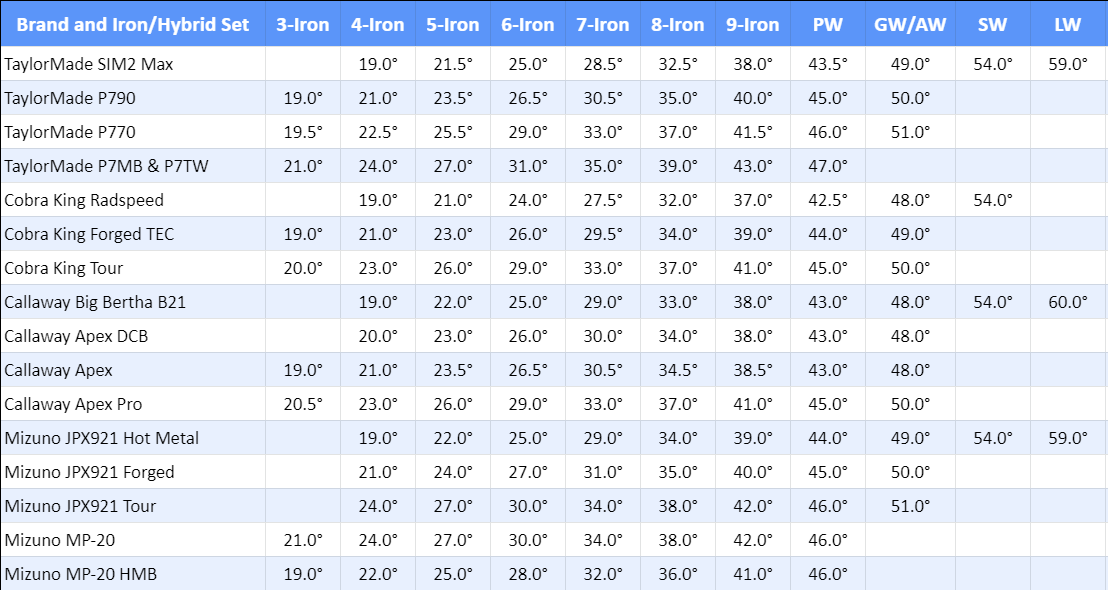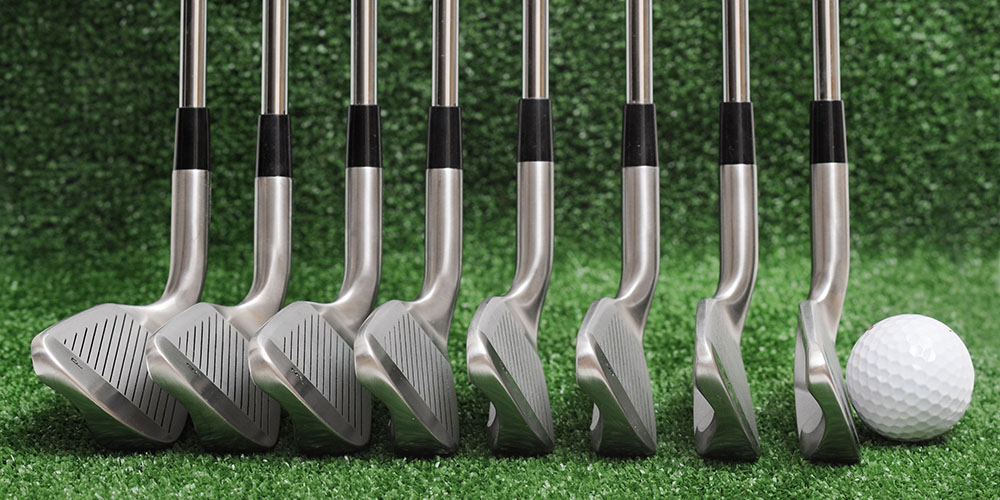Wedge Lofts Explained - Pitching, Gap, Sand, Lob
While we see a lot of questions regarding all golf club lofts, wedges lead to the most confusion.
In this guide, we'll cover the standard lofts for each wedge, take a look at how lofts differ between differently designed iron sets, and discuss optimal club gapping.
You can jump ahead to any point in this article using the following links:
Wedge Lofts
Wedges are the highest lofted golf clubs, having a higher degree of loft than woods and irons.
Nearly all iron sets will come with a pitching wedge, and most will also include a gap wedge (approach wedge/A-wedge). These wedges are primarily used for full or nearly full swing shots, so it's helpful to think of these clubs as your 10-iron and 11-iron.
Manufacturers will design the PW and GWs in an iron set with lofts for optimal yardage gaps relative to the set's 9-iron.

Iron and Wedge Lofts By Manufacturer and Club Set
As you can see in the chart of iron sets' lofts in the image above, it's rare for sets to include a sand wedge or lob wedge.
You'll mostly use your sand wedge and/or lob wedge for shorter shots around the green and out of bunkers. Most golfers prefer to buy these wedges individually to ensure they meet the requirements of the player and the course conditions they frequent.
Pitching Wedge Loft
What degree loft is a pitching wedge?
Today, a standard pitching wedge (PW) loft is 45 to 47 degrees.
Iron sets designed for beginner golfers, often called game-improvement irons, have stronger (lower) lofts than more traditional clubs. Pitching wedges that are a part of a game-improvement iron set can have lofts as low as 43 or 42 degrees to maintain yardage gaps relative to their stronger lofted 9-iron.
Sets made for the best golfers will have a pitching wedge with a higher loft, usually 46 or 47 degrees, while intermediate sets will be between the two extremes.

Mizuno JPX921 Tour Irons and Wedges
Gap Wedge Loft
The standard loft of a gap wedge (GW), also known as an approach wedge (AW), attack wedge, or A wedge, is 50 to 52 degrees.
Again, the loft of your gap wedge will depend on your iron set, with game-improvement style irons sets having gap wedges with as low as 48 degrees of loft.
For pitching wedge and gap wedge, the most important thing you need from these clubs is proper yardage gaps when your 9-iron is too much club.
Sand Wedge Loft
56 degrees is the standard loft for a sand wedge (SW), though it's common for players to fill this role with a wedge anywhere from 54 to 58 degrees.
Most iron sets don't include a sand wedge. You'll instead choose an individual wedge with the particular loft, bounce, and grind that you desire.

Cleveland RTX ZIPCORE 56° Wedge
Unlike your PW and GW, it's usually most important that you can competently use your sand wedge for shorter partial shots around the green and bunker shots rather than full shots.
Many golfers avoid taking full swing shots when they get to their highest lofted wedges because these shots are hard to hit consistently. Instead, these golfers will opt for 1/2 or 3/4 swing shots with less lofted wedges (PW and GW).
Lob Wedge Loft
A lob wedge is the golf club with the highest degree of loft. Most golfers would classify a lob wedge (LW) as a wedge between 58 to 64 degrees of loft, with 60 degrees being most common.
Compared to a sand wedge, lob wedges are even more specifically used for shorter shots around the green and bunker shots. This club really shines when you need to get the ball in the air quickly (like over a bunker lip) and have it quickly stop on the green (short-sided shots).
While some PGA Tour professionals use very high lofted wedges (up to 64°), the average player will typically struggle to hit anything with more than 58 or 60 degrees of loft consistently.
Importance of Distance Gaps Between Clubs
When choosing a driver, hitting the ball as far as possible with reasonable control is your primary focus. Beyond this club, it becomes far more critical to hit clubs to consistent distances rather than hitting them further.
Club manufacturers and club fitters use lofts and shaft lengths to optimize yardage gaps between clubs. A higher lofted club will launch the ball higher in the air, reducing how far it can travel.

Your set of golf clubs will be designed to have appropriate yardage gaps between irons and the wedges that are included.
When completing your bag with your chosen higher lofted wedges, you'll want to consider how far you hit them relative to the highest lofted club in your set. This isn't only important for full shots but also longer partial shots (3/4 to 1/2 swings). At the same time, you'll need to make sure your highest lofted wedges can be used around greens and out of greenside bunkers.
How Many Wedges Should You Have in Your Bag?
Three wedges are more than enough for golfers new to the game. You'll want to make sure you have a pitching and a gap wedge for distance gap purposes, then grab a 54 to 56-degree sand wedge for greenside bunker shots and other shots around the green.
A 54-degree wedge should be a better fit for yardage gap purposes if you're playing strongly lofted game-improvement irons. As a general rule, you don't want more than a 4-5 degree loft difference between wedges.
Before we move on from the basic wedge needs, it's important to remember that you can only have 14 clubs in your bag. This means you'll usually have to decide between more higher lofted clubs (wedges) or more lower lofted clubs (low irons, hybrids, and woods).
Even the best golfers in the world differ in how many wedges they carry. You'll see some golfers on the PGA Tour carrying three while others have four.
It makes a lot more sense for better golfers to include a lob wedge in the bag than it does for newer golfers. Better golfers will actually be able to use this club effectively around the greens, plus longer hitters may need a 58 to 60+ degree club for yardage gap purposes.
The optimal setup for you also depends on how you like to play shorter-length shots and how dialed in your partial swing game is.
Learn More About Golf Club Lofts
If you want to learn more about the lofts of each golf club, check out this guide.
